Roger Angell Is 92
We generally only note birthdays in this space when they are nice round numbers or they turn someone into a senior citizen, but the legendary Roger Angell turns 92 today and that seems like something worth celebrating. Here’s a celebration of the man in younger days that is still worth a read. Anyway, the end of the baseball season is always somehow easier to cope with because I know that in a month or so I’m going to get the long look back Angell does every year. So we have that to look forward to.
Marc Leder Is Going to Own That American Hero Cater-Waiter

Welcome to the most bizarre thing we’ve read yet this crazy election week. Marc Leder, who hosted the now wildly infamous covertly recorded Romney fundraiser, at which normal everyday white people learned that Mitt Romney hates them in the way that most Republicans only hate black people and gays, is going to nail that wonderful brave video-recording person to a wall and use him (or her!) as a sconce. “He is in the process of narrowing down the suspects and is contemplating contacting law enforcement,” is what they say. Good luck with that, because I can think of about 47% of America who’ll happily contribute to the legal defense.
Here is the second-funniest statement about Leder: “He has always stressed that he is supporting Romney because he was the inspiration for Leder starting Sun Capital. Leaving Lehman and starting Sun Capital has been a good financial move for Leder.” I mean, I know this was back in the 90s, but yeah, leaving Lehman was “a good financial move,” yes.
Also they point out that Leder is a job destroyer, basically: Sun Partners buys distressed companies and shed the employees and/or move their operations to Canada, etc. That’s how we roll in Mitt Romney’s America! Except Leder really lives in our America, where we like to have a good time. USA!
Nile Rodgers Is 60
“And then there was the matter of how they talked. My parents and their friends spoke this exotic language very slowly. There were other odd things. For instance, they often slept standing up, and this group narcolepsy could strike right in the middle of the most dynamic conversation. Someone would start a sentence: ‘Those ofay cats bopping out on the stoop are blowin’ like Birrr . . . ‘ and suddenly the words would begin to come out slower. And. Slower. Soon they wouldn’t be speaking at all. Eventually our living room would be filled with black and white hipsters suspended in time and space, while I ran through the petrified forest of their legs. My favorite game was waiting to see if the ashes from their cigarettes would ever drop. Somehow they almost never did.”
— New Yorker, guitarist and producer Nile Rodgers turns 60 years old today. Considering his work with his band Chic, and Diana Ross, and David Bowie, and Madonna, and INXS, and Duran Duran, and the B-52s and lots of other artists, one might say that he is as responsible for the sound of pop music in the 1980s as any other single person. Considering the passage above, and the essay from which it comes (as excerpted in The Times’ T Magazine)
, I would guess that the memoir he published in December, Le Freak: An Upside Story of Family, Disco and Destiny, is excellent. He is battling prostate cancer, too, as he wrote very movingly about in a blog post last year, so here’s wishing him many more happy returns.
Two Authors Enter, One Author Leaves (Dejected)
Tonight we make a mockery of books, with a series of reality-television-style degrading events that pit authors against each other and themselves, all at the behest of the Brooklyn Book Festival.
Also, if you would like a view into the future, we are beginning to keep a forward-looking events calendar, for tomorrow and beyond!
Searching With Light: The Hunt For The Next Thomas Kinkade
Searching With Light: The Hunt For The Next Thomas Kinkade
by Drew Dernavich

As we discussed last month, the passing of the Painter of Light left a huge Thomas Kinkade-sized hole in the American cultural landscape. Was he merely an outlier, or is there another Kinkade out there ready to occupy the same territory? Who, if anyone, can we look to as a successor?
Now, there are plenty of artists who can give Kinkade a run for his money in the “hearth and home” department. Too many, really. Richard Burns’ impossibly idyllic cottages look as if they were sculpted out of sherbet. Sung Kim’s scenes tap into the primal human urge for scratch n’ sniff. But when you look at the catalogs of these and other artists, you realize that what is missing is not the talent, but the scope. Kinkade’s “magic” was in his mission. To him, the light from a lamppost was not just the woozy warmth of nostalgia. It was the glare from cannon fire into the gut of America’s wayward modernism.
Which brings us to Jon McNaughton. McNaughton, who lives in Utah, can certainly nail a Kinkadian sunset landscape, but his subject matter extends to historical Christian scenery and then plows full-speed into imagery from current American politics — often all in the same scene, naturally. Like Kinkade, he is an aggressively traditionalist painter who could only exist in modern times. But whereas Kinkade was set apart by marketing, with McNaughton it’s the manifestoes.
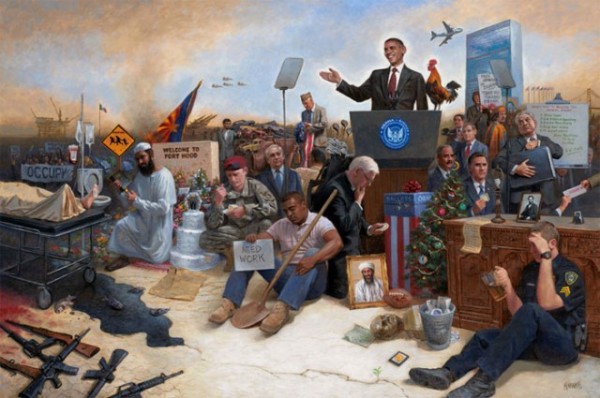
McNaughton has officially eschewed the “Tea Party Painter” label. But his work is intentionally and unmistakably conservative propaganda, in the purest sense of the word. He fulfills such obvious clichés about the American right that I sometimes wonder if he’s not the perfect punching-bag creation of the American left, even more so than Kinkade. There is intended symbolism stuffed into every inch of “The Forgotten Man,” “ Wake Up America,” and his latest work, “Obamanation” (shown above), and so that you don’t miss it, his website provides viewers with thoroughly annotated mouse-over versions. Seriously, look at all those annotations and try to find an element in these paintings that exists for artistic and non-political reasons. I was genuinely disappointed to move my cursor over the dirt in “Forgotten Man” and find that there was no ideological explanation for it. Something about sacred ground? Standing on rock-solid principles and not hippie idealism? Come on, Jon — you don’t want people trying to figure this stuff out for themselves!
Screeching partisanism aside, there actually isn’t a lot that’s new here. As David Morgan has pointed out, inserting current political figures into a religious paintings has long been a tradition in the West, with Michelangelo’s “The Last Judgment being perhaps the most well-known example. (By the way, if you want some mouse-over goodness, visit this Interactive Vermeer.)
And yet, regardless of passion or point of view, who wants to hang a legal brief or a campaign speech on their wall? I want to see how well you can paint with a brush, not a hammer. Like Kinkade’s paintings, McNaughton’s works fail on their own terms. Kinkade was so singularly obsessed with comfort that his work became creepy. McNaughton’s works miss because airtight arguments are not made in painted form. Take “One Nation Under God. The artist probably has a powerful point to make, but has instead chosen to flood this image with a massive firehose of symbols. One symbol may have archetypal power and several may have allegorical power, but a hundred symbols interacting with each other is chaos. Nothing has room to breathe.
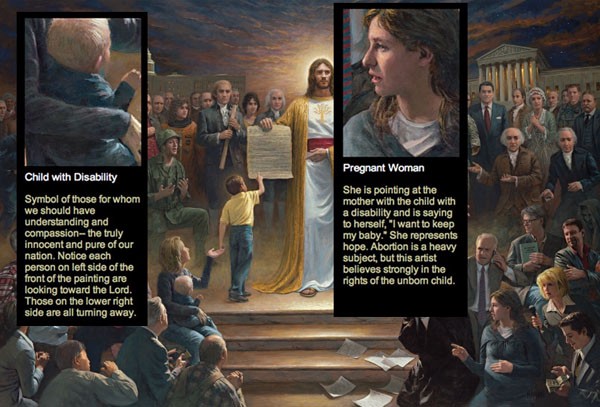
This painting is executed with the confidence of a guy who appears to have everything figured out: here are the good guys, here are the bad guys, and here’s where they all belong. But when you dive into the annotations, you get a sense that McNaughton realizes he needs to make finer distinctions as well. His paintings, though, aren’t capable of doing that work. He has to rely on his notes to explain the contradictions and layers in what they’re seeing. How else are we supposed to ascertain the nature of this dialogue between the “woman with child with disability” and the pregnant woman without his online cheat sheet? How are we supposed to know that the pregnant woman is among the people “turning away from the Lord” who represents hope? Does Christa McAuliffe represent herself, or the space program, or just the members of the space program who aren’t humanists? And really, why aren’t the ‘left-wing people’ on the left? These would be stupid questions to ask of any other artist, but not for an artist who seems so committed to expunging all elements of mystery from his work.
And, as was observed here, McNaughton’s image of Obama holding a flaming Constitution can be interpreted in the exact opposite way as it was intended: It’s not clear whether he torched the document himself, or if he’s lamenting its destruction. If a title or an online screed is the only way I can comprehend your painting’s meaning, then why not just stick to the online screed? Sean Hannity allegedly shelled out $300,000 for this, and if it’s true, he’s a sucker: he bought a six-figure YouTube comment.
Are other people buying McNaughton’s work? Apparently so. Somewhere there is a fanatic who is thinking, “I really dig the casually angled placement of the symbolic ‘Marbury v. Madison’ court case document!” But it’s hard to imagine The Painter of Heat franchising his wares next to Cinnabon like the Painter of Light did. We will have to look elsewhere for an heir, and continue our search next month.
Previously: The Hunt Begins
Drew Dernavich is a cartoonist for the New Yorker magazine (not that cartoonist — the other one) and the co-creator of the cartoon improv show Fisticuffs! He is on Twitter.
We Don't Need No Water, Let That Forest Fire Burn!
“The first year after a fire is when the magic really happens.”
— University of Montana ornithologist Richard Hutto says the United States Forest Service should stop doing their “controlled burns” and let massive conflagrations blaze on unabated.
33 Names That It's Safe To Call Baxter The Human-Friendly Robot Because Of His Safety Sensors And...
33 Names That It’s Safe To Call Baxter The Human-Friendly Robot Because Of His Safety Sensors And Programmed “Compliance” System

1. Lug Nuts
2. Metal Mouth
3. Rusty
4. Chrome Dome
5. R2-DPoo
6. C-3PSlow
7. “Baxter”
8. Michael Showalter
9. Rethink Again
10. Rosie
11. Inspector Vadge-it
12. The Nerdinator
13. Dorkbot
14. Spazmatron
15. Clunky
16. Virus Breath
17. Soft-In-Space
18. Short Sprocket
19. Floptimus Prime
20. Alfalfa 5
21. Doll-E
22. AstroToy
23. The Iron Pliant
24. Spamdroid
25. Robotard
26. Glitch
27. Jaime Sommers
28. Slow-Bo-Cop
29. Weaki
30. Small Wonder
31. Blunderdrone
32. Deuche Ex Machina
33. Etch-A-Face
The Hollywood Life Of Walter Mitty
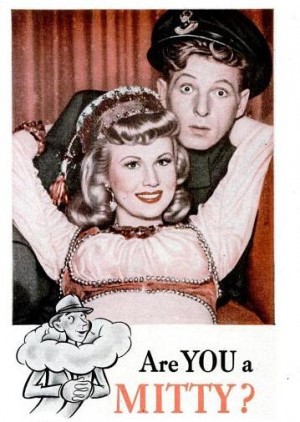
News that “The Secret Life of Walter Mitty” is being made into a big new movie starring Ben Stiller is somewhat worrying, and I say this as one whose favorite movie may well be Zoolander. Tad Friend’s recent New Yorker profile of Stiller, “Funny is Money” (subscription-only) is full of disquieting (and fascinating) details about the project; apparently there’s a comic shark attack involved. It’s a mystery how Thurber’s 1939 story of an ordinary man’s daydreams, so small in scale, so evanescently brief (just 2,200 words), and so deceptively modest in its message, should have attracted the notice of so many producers of large and noisy entertainments. But it has. There was a Broadway musical in 1960 that ran for 96 performances, despite the wholesale invention of an all-new character named, for serious, Willa da Wisp. And before that there was the first film adaptation, released in 1947 and starring Danny Kaye, then a huge star of crowd-pleasing comedies, like Ben Stiller is now.
The really surprising thing is that these big-budget adaptations so far have been successful with audiences, despite the massive liberties taken with the original story. This practice has been enraging Mitty fans since the 1940s, when talk of a movie began. “Touch one hair of Mitty’s head, and we’ll bomb the studio,” wrote a gang of (real) South Pacific fighter pilots, according to Collier’s Magazine.
There was all kinds of trouble with that first movie, which I am going to tell you about, but first let’s talk about James Thurber.
***
Thurber was a depressive and nervous guy, forever uncertain of himself and his place in the world, though he achieved worldwide fame in his lifetime. He was also the best American prose stylist of his era, and quite possibly of ever. Much has been written about Thurber’s racism, narrow-mindedness and misogyny, but I view him as the product of his times, an equal-opportunity critic of the human condition, both noble and wise, who called things as he saw them. Despite the essential darkness of Thurber’s character, his subtle optimism is ever-present, like a thread of gold shot through the fabric of all he wrote. Racism: what are we to make of the race consciousness of a man who found nearly everyone, including himself, a little bit scary and weird? I don’t know exactly what the word “colored” meant when spoken by someone born in Ohio in 1894, or what alternatives to it there may have been, but I can say that I have never detected any mean-spiritedness or gratuitous animosity toward those different from himself in any of Thurber’s writing, whether published or unpublished. And as for his misogyny, the fable “The Last Flower” pretty much says it all: Thurber’s idea of paradise, of hope itself, consisted of a man and a woman alone together in a garden.
For all his elegance, Thurber was also an Ohio boy who’d come up poor, and much of his work is to do with the most ordinary people, themes, and situations. A cocktail party that is rapidly going south. A terrible, quiet marital battle in the car. A big old house full of crazy relatives spending the night. An ordinary man sent out by his bossy wife to do some errands: his mind begins to wander, to produce vivid daydreams in which he is engaged in the most heroic exploits. Will he remember to buy the puppy biscuit?
***
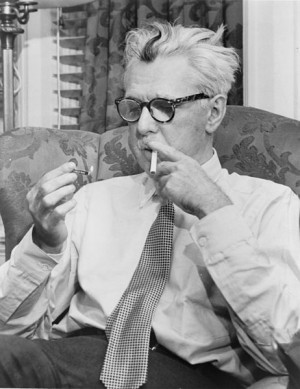
The likeness of Thurber to Kafka has been remarked before, but insufficiently, maybe because we see the jet-black humor of Kafka as an imported commodity; European, exotic, entirely foreign. Here is how the two are alike, though: Thurber abided in uncertainty and pain always, every minute, in his work and in his life, and though the pleasures he was able to enjoy and to transmit are all the more beautiful and delicate for their fragility, there’s always been a tendency among casual American readers to take Thurber’s hilarity as the point of his work. To see his comedy as shtick, rather than the dead serious moral philosophy that it really is. And though that Kafkaesque flavor of black comedy has become an ever-stronger strain in American humor since Thurber’s time, we still have a lot of comedy that is like “Jackass,” as well, comedy that is purely for fun and not for thinking. Thurber actually works pretty well, in that casually hilarious way.
But it was Thurber who first opened the vein that later American humorists like Lenny Bruce and Bill Hicks and Louie CK continued to mine. These writers never cast off their essential seriousness, a deep sense of the gravity and precariousness of the human condition, but incorporate an antic humor into a larger worldview that is informed by grief and pain. We might put it this way: Thurber was the first American to turn terror into comedy, and that’s why he’s our Kafka. The difference is that if Thurber had written The Trial, Josef K. might easily have been set free on the whim of a drunken night porter and escaped into God knows what altered condition, as Walter Mitty does. The world of Thurber is both crazier and more lifelike than Kafka’s, because in Thurber there is room for silliness and fun, for pleasant surprises, and luck, and the pleasures of imagination, love and beauty, and the chance of a meaningful interaction with another person — as well as room for fear, bewilderment and disaster.
Then there is the question of literary sophistication. This unassuming Midwesterner, for all his celebrated shyness and awkwardness in person, contributed a great deal to defining the The New Yorker’s tone and style in his many years publishing there, traces of which are still visible: a certain modesty, an open delight in the absurd, a fondness for correct grammar (as opposed to plain pedantry), and a mordantly undeceived appraisal of one’s own place in the world. Here he is, reviewing a biography:
Let me be the first to admit that the naked truth about me is to the naked truth about Salvador Dali as an old ukelele in the attic is to a piano in a tree, and I mean a piano with breasts. Señor Dali has the jump on me from the beginning. He remembers and describes in detail what it was like in the womb. My own earliest memory is of accompanying my father to a polling booth in Columbus, Ohio, where he voted for William McKinley.
***
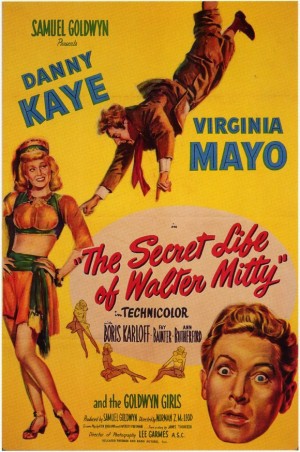
The producer of the first Walter Mitty film was Samuel L. Goldwyn, and he hired Norman Z. McLeod to direct and Danny Kaye to star. Any Thurber fan of the time would have scented trouble immediately. These guys were gag men given to every kind of mugging, pratfalling, slapsticky gimmick; it was like hiring Rob Schneider to star in a Charlie Kaufman story, and Tyler Perry to direct. McLeod had just directed Kaye in The Kid From Brooklyn, a story about a mild-mannered milkman who becomes a world-champion boxer. Before that he’d directed the Topper movies, and a number of other lightweight comedies; earlier still, two of the lesser Marx Brothers movies: Horsefeathers and Monkey Business. “He was a very nice guy and a fairly good director,” said Groucho Marx, “but no genius.”
Sam Goldwyn went through a passel of writers to adapt “Walter Mitty,” and none of them were James Thurber. Not until the very end, when there was a matter of weeks left before shooting began. Still not happy with the script, he finally contacted Thurber, who agreed to do a script polish with Ken Englund, one of Goldwyn’s writers. The two developed new scenes and reconfigured the script according to Thurber’s ideas. He wrote Ken Englund a letter during this time that I read recently in the wonderful Thurber archive at The Ohio State University’s Thompson Library:
[O]ne of my strongest convictions about this whole picture is that the dream scenes should be kept in a high romantic key, and should never descend to anything of a slapstick nature purely for the sake of laughs. If this picture has any one special value, it is that it represents the kind of daydreams the average man dreams up, and I believe that every person in the movie audiences all over the country will recognize himself in these dreams, if we keep them true and right. The daydreamer — that is, you and me and everybody else — always imagines himself engaged in high and fine exploits and adventures, and he never dreams of himself as a comic or foolish character. The dreams will be funny simply and only because they are the true representations of the average man’s secret notions of his own great capabilities.
The anxiety with which many viewed the movie’s progress was partly attributable to the story’s popularity during the war. Fighter pilots identified themselves as “Walter Mitty” on the radio, according to various Thurber bios, and Life said, “Soldiers liked [the story] so well that they formed Mitty Clubs, with ‘pocketa’ as password.”
The OSU archive also contains a wonderful letter from Thurber to Mr. Joseph F. Brady at The New York Times from August ’46, over a year before the movie’s release, in which he says, “I gather that there is a tendency afoot to lay the blame on me for whatever deviations there may be in the film from the true character and behavior of the hero. I think it is only fair to set the record straight on this point.”
He goes on to say that he’d worked on the script for ten days with Ken Englund “putting in and taking out. I think we improved the script by tinkering with it but there was never any question of my taking the thing over and writing it myself. […] The daily life of Walter is and should be humdrum, and this is a way of life to which the American movies of our time are utterly opposed. It would be as difficult to present a humdrum Walter Mitty in a technicolor movie as it would be to do the witch scene from Macbeth on the center court at Wimbledon at high noon of a summer day.”
The motion picture, Thurber observes, is being produced for “the millions of Americans who never even heard of Walter. These people I am told go movies to avoid the humdrum and if they are forced to watch a quiet dinner party in progress on the screen they will not be completely happy unless one of the guests shoots the hostess.”
The archive reveals that Thurber was reasonably happy with the script, once he’d gone over it with Englund. But in the event, none of their new scenes made it into the film, because Danny Kaye and his “people” finally succeeded in turning the story into a Danny Kaye vehicle, complete with gags and goofy face-making, and so on. For comparison, here is the RAF scene from the story (the whole scene):
He picked up an old copy of Liberty and sank down into the chair. “Can Germany Conquer the World Through the Air?” Walter Mitty looked at the pictures of bombing planes and of ruined streets.
. . . “The cannonading has got the wind up in young Raleigh, sir,” said the sergeant. Captain Mitty looked up at him through tousled hair. “Get him to bed,” he said wearily, “with the others. I’ll fly alone.” “But you can’t, sir,” said the sergeant anxiously. “It takes two men to handle that bomber and the Archies are pounding hell out of the air. Von Richtman’s circus is between here and Saulier.” “Somebody’s got to get that ammunition dump,” said Mitty. “I’m going over. Spot of brandy?” He poured a drink for the sergeant and one for himself. War thundered and whined around the dugout and battered at the door. There was a rending of wood and splinters flew through the room. “A bit of a near thing,” said Captain Mitty carelessly. “The box barrage is closing in,” said the sergeant. “We only live once, Sergeant,” said Mitty, with his faint, fleeting smile. “Or do we?” He poured another brandy and tossed it off. “I never see a man could hold his brandy like you, sir,” said the sergeant. “Begging your pardon, sir.” Captain Mitty stood up and strapped on his huge Webley-Vickers automatic. “It’s forty kilometers through hell, sir,” said the sergeant. Mitty finished one last brandy. “After all,” he said softly, “what isn’t?” The pounding of the cannon increased; there was the rat-tat-tatting of machine guns, and from somewhere came the menacing pocketa-pocketa-pocketa of the new flame-throwers. Walter Mitty walked to the door of the dugout humming “Auprès de Ma Blonde.” He turned and waved to the sergeant. “Cheerio!” he said. . . .
Something struck his shoulder. “I’ve been looking all over this hotel for you,” said Mrs. Mitty. “Why do you have to hide in this old chair? How did you expect me to find you?”
And here’s how the beginning of the RAF scene turned out in the movie.
So, horrible, right? Nope. No less an authority than Bennett Cerf had this to say in The Saturday Review, a totally respectable publication, after having seen an early screening.
Danny Kaye’s antics in the screen version of Jim Thurber’s classic “The Secret Life of Walter Mitty” are unbelievably hilarious, and the picture probably will delight everybody but the Ancient Order of Mitty Worshippers (Frank Sullivan, president) who, when they see how little is left of the original story, may blow out the brains of either themselves or the producer. Thurber himself seemed a bit puzzled at the conclusion of the prevue. ‘Anybody catch the name of this picture?” he asked.
Thurber didn’t confine his complaints about the movie to private screenings; he went off about it in public, too. An early pre-release review in Life included this:
James Thurber, a mild man, grows almost profane when he thinks of how his story […] has been corrupted. He calls the result The Public Life of Danny Kaye and is appalled by the star’s songs in gibberish, the Dick Tracy plot and the traditional Goldwyn opulence of production. “It began to be bad with the first git-gat-gittle,” he says. “If they’d spent one tenth of the money, it would have been 10 times as good.”
Goldwyn wasn’t about to take that lying down. He sent his own letter to Life, innocently claiming that he was “somewhat startled” to hear that Thurber hadn’t loved the movie. Pfft! Such a fibber!! Goldwyn then cherry-picked a bunch of Thurber’s comments regarding the rewrites he’d done with Englund, and the wily producer had the gall to present these to the press as evidence of Thurber’s approval, despite having cut all the scenes in question. He was an awful writer, unfortunately. “As I need not tell you, the original story, ‘The Secret Life of Walter Mitty” is a pure gem, which added great luster to the little magazine in which it was first published.”
Thurber was incensed (also, I think, filled with glee at a chance to get back at Goldwyn) and wrote a scathing response; both letters were offered under the headline “Goldwyn vs. Thurber: Producer and Author dispute over ‘Walter Mitty’” on the eve of the movie’s release in September. From Thurber’s letter:
[…] During this vital period my counsel, criticism, and collaboration were never once sought […] The miracle expectancy of Mr. Goldwyn is as famous as his inability to comprehend the problems of writing. He told me the first sixty pages were all right and asked me not to read the last 100 pages, which he said were too “blood and thirsty.” I read the entire script, of course, and I was horror and struck. Mr. Goldwyn expected me to remove the blood and thirst without reading it but somehow to preserve the melodrama. It was a task for wizards, stated in the wondrous dialect of Oz.
As for the new Walter Mitty movie, I fear we can expect all the melodrama and the slapstick that we saw in the old one, though I should have loved to see Ben Stiller in a faithful version of this story, which would make a very lovely movie. Stiller can be both Everyman and also a strangely elegant and romantic figure (a rare combination, and one essential to the character of Mitty). I admit, it pained me to hear about the shark attack. But it bears remembering that this story has withstood three quarters of a century of invasive re-workings without any real harm coming to its beguiling hero, whose wayward charm has become the indestructible stuff of legend, as his story’s concluding lines (and ours) demonstrate:
To hell with the handkerchief, said Walter Mitty scornfully. He took one last drag on his cigarette and snapped it away. Then, with that faint, fleeting smile playing about his lips, he faced the firing squad; erect and motionless, proud and disdainful, Walter Mitty the Undefeated, inscrutable to the last.
Maria Bustillos is the author of Dorkismo and Act Like a Gentleman, Think Like a Woman.
